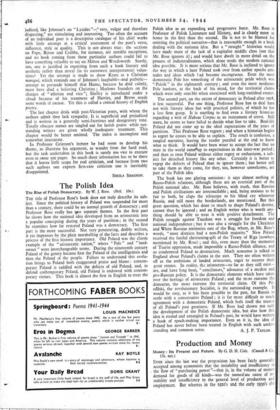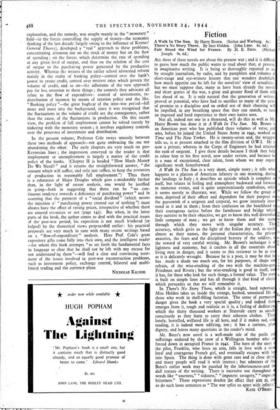Production and Money
Money : Its Present and Future. By G. D. H. Cole. (Cassell & Co. 15s. net.)
EVER since the last war the proposition has been fairly generally accepted among economists, that the instability and insufficiency In the flow of "purchasing power"—that is, in the volume 9f money demand for goods of all kinds—was the immediate cause of in- stability and insufficiency in the general level of production and employment. But whereas in the 1920's and the early 1930's the explanation, and the remedy, was sought mainly in the " monetary " field—in the forces controlling the supply of money—the economic thinking of the last decade ;largely owing to the influence of Keynes' 'General Theory), developed a "Teal " approach to these problems, concentrating attention not on the stock of money but on the flow of spending ; on the forces which determine the rate of spending at any given level of output, and thus on the relation of the cost of output to the purchasing power generated by the productive activity. Whereas the writers of the earlier school advocated reform mainly in the realm of banking policy—control over the bank's power to create credit, control over 'interest rates which govern the volume of credit, and so on—the adherents of the new approach pay far less attention to these things ; the controls they advocate all relate to the flow of expenditure: control of investments, re- distribution of incomes by means of taxation policy and the like. " Banking policy "—the great bugbear of the inter-war period—fell more and more into the background, since it was recognised that the fluctuations in the volume of credit are the consequence, rather than the cause, of the fluctuations in production. On this recent view, the problem of full employment cannot be solved merely by tinkering with the monetary system ; it involves regulatory controls over the processes of investment and distribution.
In the present volume, Professor Cole sways uneasily between these two methods of approach—not quite embracing the one nor abandoning the other. The early chapters are very much on pre- Keynesian lines ; the impression conveyed to the reader is that employment or unemployment is largely a matter of the credit policy of the banks. (Chapter II is headed " How Much Money Do We Need? " and it returns the straightforward answer, " the amount which will suffice, and only, just suffice, to keep the resources of production in reasonably full employment.") Thus there is a refutation of Major Douglas which goes considerably farther than, in the light of recent analysis, one would be justified in going—both in suggesting that !there can be "no con- tinuous tendency towards a deficiency of purchasing power" and in asserting that the payment of a " social dividend " (which means the injection (V " purchasing power created out of nothing ") must always have the effect of raising prices, irrespective of whether there are unused resources or not (page 143). But when, in the latter parts of the book, the author comes to deal with the practical issues of the post-war period, his exposition is not much hindered (or helped) by the theoretical views propoundttl earlier: his practical proposals are very much in tune with many recent writings based on a " flow-of-expenditure " analysis. Here Prof. Cole's great expository gifts come fully into their own, and the intelligent reader —for whom this book attempts "to set forth the fundamental facts in language so clear that he shall not be left with any excuse for not understandng them "—will find a clear and convincing treat- ment of the issues involved in post-war reconstruction problems, such as investment policy, exchange control, bilateral and multi- lateral trading and the currency plans.
NICHOLAS KALDOR.



























 Previous page
Previous page